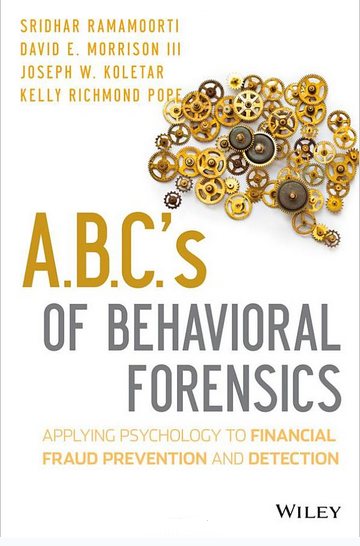This research was funded by the Institute for Fraud Prevention at West Virginia University of which Dr. Sri Ramamoorti was a Board member representing Grant Thornton LLP.
In this paper we use a primarily “behavioral lens” (cf. Ramamoorti, 2008; Ramamoorti & Olsen, 2007) to try to understand the state-of-mind and motivations of the C-level suite/white collar offender before, during, and after the perpetration of management fraud. We offer a useful conceptual approach called “A-B-C Analysis” to understand the incidence of fraud from individual and group perspectives, as well as more macro-oriented, cultural/contextual levels.
It is our hypothesis that fraud occurs either because of an individual criminal’s calculated/intentional betrayal of trust, a duo or team of “bad boys” who push ethical envelopes, and/or an organizational/social/national culture of passivity, indifference or accommodation that is tantamount to condoning such behaviors. We have called it the Bad Apple, Bad Bushel, or Bad Crop Syndrome: the so-called ABCs of white collar crime. Our interdisciplinary review of the literature, spanning (social) psychology, sociology and criminology, psychoanalysis and psychiatry, and anthropology, as well as our collective experience as practicing fraud examiners, investigators and consultants, have yielded some rich insights including that:
(1) Motivation for Fraud is Under-Hypothesized in Extant Literature: The motivation for fraud is under-hypothesized by the so-called “fraud triangle” consisting of perceived opportunity, perceived pressure, and rationalization (ACFE Fraud Examiners Manual, 1995; Cressey, 1953), and that there exist other motivations such as those based on “fraudster’s emotions” (e.g., revenge, social status comparisons, “crimes of passion” etc.), mastery of a situation or technique (e.g., a “catch-me-if-you-can” game), “self interest or group interest,” “noble cause corruption,” etc. This expanded set of cognitive, conative, affective, and other motivational variables underlying the perpetration of fraud is better accounted for by psychologist Michael Apter’s reversal theory (Apter, 1997, 2001, 2007a & 2007b). Fraud is frequently committed by manipulating human emotions.
(2) Standard Legal Definition of Fraud is Undesirably Narrow: The present legal definition of fraud as including “intent” or “scienter” as a key element may be undesirably narrow and constraining in adequately addressing the fraud problem; after all, you cannot “improve a (fraud detection) process without first understanding it.” This finding has potentially significant future consequences for not only re-appraising the standard definition of fraud (e.g., Black’s Law Dictionary, 1979) but also for criminology and law enforcement. We need a richer vocabulary and a deeper understanding of the underlying behavioral motivations for white collar crime.
(3) Unpacking “Greed” has Explanatory Value: There is considerable value to unpacking the common sense explanation for fraud, viz., greed, pure and simple. Without further delving into the meaning of the folk psychology term, “greed,” why it manifests itself in different ways, in different times and in different cultures, it can only be called “labeling” and naming something does not and cannot constitute a valid and credible explanation. In this connection, the research stream in social psychology on “counterfactual thinking and reasoning” appears to have considerable explanatory promise and must be further explored (see Roese & Olson, 1995).
Towards the end of the paper we provide a list of research questions that could be useful to academic researchers in crafting a responsive research agenda that exploits insights from the behavioral sciences. Two appendices deal with special topics: Appendix 1 illustrates the value of taking an evolutionary psychology approach; Appendix 2, “Greed Takes the Blame,” is a provocative editorial that explores “greed” as the prevailing conventional wisdom in accounting for fraud; and Appendix 3 suggests that academia is recognizing there may be more to finance than just rigorous economic foundations, incorporating behavioral insights is inexorable.
Click here to download the IFP White paper Bringing Freud to Fraud
Click here to download the IFP White paper Bringing Freud to Fraud
